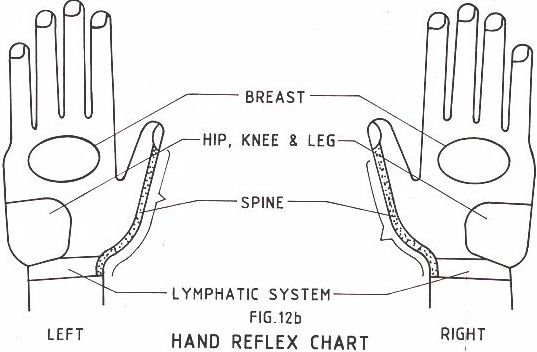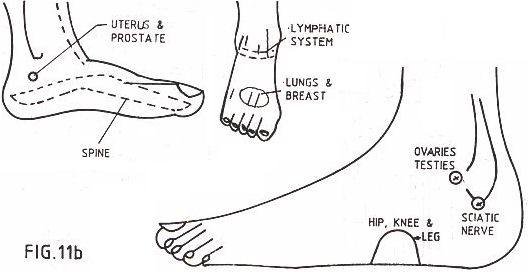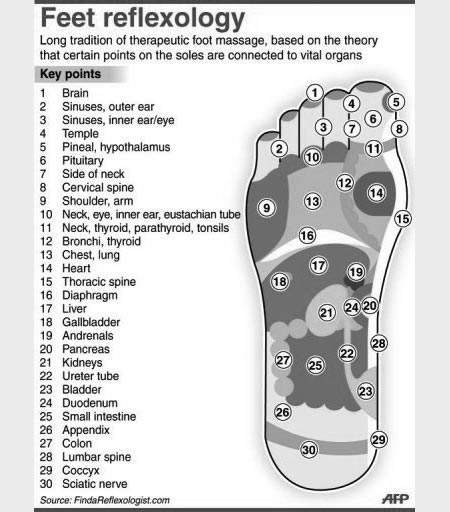LELAH
tekanlah secara berganti zone liver kedua belah tapak tangan secara berganti-ganti.
JANTUNG BERDENYUT KENCANG
refleksolgi dilakukan dibahagian sisi KUKU jari tengah
DIABETES.
refleksolgi dilakukan dibahagian PANGKAL IBU JARI secara perlahan
INSOMNIA
refleksolgi dilakukan dibahagian PANGKAL JARI TELUNJUK
KESEJUKAN
refleksolgi dilakukan dibahagian BELAKANG TAPAK TANGAN
HYPERTENSION
refleksolgi dilakukan dibahagian sisi jari tengah
BAHU TEGANG
Pangkal jari telunjuk dan kelingking
DARAH RENDAH
refleksolgi dilakukan dibahagian BELAKANG TAPAK TANGAN tempatnya dekat pergelangan tangan
REFLEX ZONES
Saturday 1 October 2011
Wednesday 7 September 2011
WHAT IS REFLEXOLOGY?
REFLEXOLOGY
Reflexology is also known as reflex zone therapy and uses specific points on the soles of the feet or palms of the hands to influence certain organs and to treat disorders.
Reflexology is the practice of working reflexes in the feet, hands or ear to treat the corresponding parts of the body. It is a method of activating the healing powers of the body.
It causes responses (relaxation) in corresponding parts of the body which is the first step to normalization. The body returns to a state of equilibrium called homeostasis where easy circulation of blood takes place supplying nutrients and oxygen to the cells.
What are the effects?
It reduces stress, improves blood circulation, cleanses the toxins from the body, revitalises energy and balances the whole system.
Reflexology can:
- release stress and tension
- improve blood circulation and activates lymph drainage
- assist in elimination of toxins
- strengthen the immune system and harmonises vital functions
- enable a deep state of relaxation and well being
- ease pregnancy, labor and delivery
How to get the reflex points?
Imagine the foot or hand as three dimensional representation of the three dimensional body
 to fix the internal organs in position on both the hands and feet.
to fix the internal organs in position on both the hands and feet.What causes imbalance?
Zonal imbalance is caused by internal blockages like calcification or pooling of lymph fluid or by external blockages like corns and calluses etc.
How to apply pressure on the reflex points?
Thumb walking or finger walking technique is used in which the thumb bent at the first joint is pressed bite by bite all over the feet or hands. Again pleasurable pain is the goal.
Can it be done by oneself?
Yes. It can be done by self and it is more effective when the reflex organ is imagined at the time of applying pressure and coordinated with breathing by closing the eyes.
How long are these points to be activated?
Apply rhythmic pressure for nearly fourteen times for curative purpose and for preventive purpose apply pressure for seven times.
Zone therapy is the basis of hand and foot reflexology Working on the entire foot or hand affects the whole body. Here, in addition to longitudinal zones, the body is also divided into lateral zones. The main purpose is to fix the image of the body onto the foot or hand in proper perspective and location.
THE OBJECTIVE OF REFLEXOLOGY
The objective of reflexology is to result in the restoration of homeostasis - internal equilibrium where organs and glands work optimally and in harmony to help promote health and in so doing help prevent illness and disease.
Reflexology is also used with great success to relieve stress and the physical demands made on the body, as well as stimulating the immune system.
Reflexology is based on the principles similar to those of acupuncture: that lines of energy that connect the feet and hands to various points of the body exist in every human being; consequentially, the entire organism can be cured by working on corresponding reflex points of the feet and hands. The lines of energy of reflexology are different than the meridians of acupuncture, but both methods derive from antique Chinese therapies.
The first document regarding the therapy that we refer to today as reflexology was found in an Egyptian tomb of 2330 B.C.: a painted mural represents a therapist who is holding the feet of a patient as he massages them with his hands. It has also been discovered that reflexology was known by primitive tribes of Africa and the American Indians.
Documentation relative to reflexology as it is applied today comes from the studies and experimentation done by Doctor William Fitzgerald and Eunice Ingham.
ZONE THERAPY
Around 1913, Doctor Fitzgerald, an American otolaryngologist, began practicing a healing method that later became known as zone therapy. The interest for this treatment that was based on pressure points had been sparked in Doctor Fitzgerald after having read various works by European doctors who had been applying these theories since 500 A.D.; he most likely became familiar with these theories while working in Vienna.
Fitzgerald noted that the intensity of the pain – affected by the same disturbances and the same treatments – varied greatly from patient to patient. He discovered that when he put pressure on certain parts of the body that were in pain, he was able to create an effect similar to that of an anaesthesia. In some cases, the patients were able to do this same therapy to themselves.
Fitzgerald noted that the intensity of the pain – affected by the same disturbances and the same treatments – varied greatly from patient to patient. He discovered that when he put pressure on certain parts of the body that were in pain, he was able to create an effect similar to that of an anaesthesia. In some cases, the patients were able to do this same therapy to themselves.
After further developing his research, Fitzgerald established a system that was formed by ten zones of the body, the important being derived from the fact that each zone had an energetic connection with determined areas of the body, allowing one area to influence another by applying pressure to the corresponding points.
For example, if pressure was applied to a zone corresponding to the ear, an anaesthetic effect was experienced on that ear. In every day life, many people unconsciously apply zone therapy: grinding ones teeth when he feels pain (pressure points of the mouth region) or tightening the grip to the dentist chair to alleviate some of the pain with dental intervention (pressure points on the hands) are both ways that people apply zone therapy.
THE ZONES OF THE BODY
Doctor Fitzgerald established a map of the body that divided it into ten longitudinal zones.

As indicated in Figure 1, a central, vertical line crosses the entire body; to its right and left there are 5 zones, each being in relation to the hands and feet:
- Zone 1 begins at the thumb, goes up the arm to the brain and then back down to the large toe;
- Zone 2 begins with the second finger (the index), goes up the arm to the brain and then back down to the second toe of the foot;
- Zone 3 begins at the third finger (the middle), goes up the arm to the brain and then back down to the middle toe;
- Zone 4 begins at the ring finger, goes up the arm to the brain and then back down to the fourth toe;
- Zone 5 begins at the pinky finger, goes up the arm to the brain and then back down to the little toe.
These longitudinal zones are of similar width and divide the body down the front and back. They are identified as sections of the body and not as thin lines (like the meridians in acupuncture).
The description of the various zones can also be done in reverse, thus each zone begins at the toe, moves up through the brain and returns down the arm to the corresponding finger.
The importance of the ten longitudinal zones is in the fact that each part of the body is found in a determined zone and is connected to an energy flow that exists within that zone; therefore, both parts influence each other. The confirmation of this can be seen in the example of kidney problems, that are often connected to similar problems in the eyes, in fact, the kidneys and the eyes are in the same zone. (Figure 2).
The practical application of zone therapy makes it possible to treat a part of the body by putting pressure on the corresponding point of the body that is easily accessible.
Doctor Fitzgerald used every type of instrument to obtain the right pressure: clothes pins, barrettes, elastic bands, headbands, etc… The clothes pins were clipped onto the points of the finger, elastic bands were placed around the finger; each served to put pressure on the zone of the hand that benefited the part of the body that was being cured.
In zone therapy, treatment is mostly on the hands and feet, the ankles and wrists and the knees and elbows. It has been proven that the pressure should be a minimum of one kilogram and a maximum of ten kilograms for a period of 30 seconds to 5 minutes. If the treated area starts to turn blue, this should be considered a sign to take off the pressure immediately and massage the area to bring back normal circulation.
These methods are used to cure a series of problems including migraines, eye problems, cysts of the breast or mammary glands, fibromas and breathing problems. Doctor Fitzgerald spoke also of the existence of the ten zones on the tongue and in the mouth, adding to the previously established longitudinal zones of the body.
The research of Doctor Fitzgerald was seen with great scepticism by most of his colleagues, but some of these same colleagues, after experimenting with his approach, had optimal results and became faithful supporters of his methods. It was Doctor Edwin Bowers, a medical journalist, who proposed that the methodology be called zone therapy. His work in this field was further continued by other American physicians, namely Doctor George Starr White, Doctor Joe Riley and his wife Elizabeth Riley, all experts in this field.
Doctor Riley introduced the definition of “hook therapy”, in while the hands of the therapy become hooked on a part of the body to further manipulate the relative points; this was used for articulation and tissue therapy. Reflexology still follows these original approaches with some modifications brought by new discoveries in the field.
Eunice Ingham, a student of Doctor Riley in the field of zone therapy, became the most important pioneer of reflexology in its modern form. After reading the works of Doctor Fitzgerald and his colleagues, she understood that the entire organism could be cured by putting pressure on the reflex points that were found in the feet and hands.
Sterility
The incapacity to procreate on the part of a man or woman or both by cause of small imperfections. The hormonal imbalance of the glands that are connected to reproduction are always connected with this problem.
ZRD: testicles, prostate and ovaries, Fallopian tube, uterus
ZRI: hypophysis, thyroid, lymphatic system.
The incapacity to procreate on the part of a man or woman or both by cause of small imperfections. The hormonal imbalance of the glands that are connected to reproduction are always connected with this problem.
ZRD: testicles, prostate and ovaries, Fallopian tube, uterus
ZRI: hypophysis, thyroid, lymphatic system.
Constipation
The difficulty of constipation is caused by a lack of muscular tone in the intestines that can be caused by a diet low in fiber, lack of physical exercise, fatigue or anxiety.
ZRD: large intestine.
ZRI: small intestine, suprarenal glands, solar plexus, liver, lower spine.
The difficulty of constipation is caused by a lack of muscular tone in the intestines that can be caused by a diet low in fiber, lack of physical exercise, fatigue or anxiety.
ZRD: large intestine.
ZRI: small intestine, suprarenal glands, solar plexus, liver, lower spine.
Tension (and stress)
A large percentage of the problems that affect people today are caused by tension and stress. The organism is capable of confronting a certain amount of stress: daily lifestyles, that forces us to remain under pressure constantly does not permit us to give correct care to our bodies and thus produces illness. The tension damages each organ of the body and provokes problems like: headaches, digestive ailments, backaches, neck pain, menstrual and hormonal imbalances and allergies. The capability to relax is essential for the health of our organism: it attenuates or even eliminates any ailments caused by tension.
ZRD: at the origin of the pain or illness.
ZRI: solar plexus, suprarenal glands, hypophysis.
A large percentage of the problems that affect people today are caused by tension and stress. The organism is capable of confronting a certain amount of stress: daily lifestyles, that forces us to remain under pressure constantly does not permit us to give correct care to our bodies and thus produces illness. The tension damages each organ of the body and provokes problems like: headaches, digestive ailments, backaches, neck pain, menstrual and hormonal imbalances and allergies. The capability to relax is essential for the health of our organism: it attenuates or even eliminates any ailments caused by tension.
ZRD: at the origin of the pain or illness.
ZRI: solar plexus, suprarenal glands, hypophysis.
Muscular Tension
Caused by fatigue or movements inappropriate for a muscle, it creates temporary pain and discomfort. The reflexology treatment helps to recuperate but it is also necessary to keep the muscle rested until full recovery.
ZRD: at the origin of the pain, massage directly on the connected zone.
ZRI: solar plexus, suprarenal glands, parathyroid.
Caused by fatigue or movements inappropriate for a muscle, it creates temporary pain and discomfort. The reflexology treatment helps to recuperate but it is also necessary to keep the muscle rested until full recovery.
ZRD: at the origin of the pain, massage directly on the connected zone.
ZRI: solar plexus, suprarenal glands, parathyroid.
The above-listed pathologies (sterility, tension and stress, muscular tension) obtain benefits from reflexology of the foot, stimulation by massage of the appropriate areas of the feet goes to work on the corresponding organs and stimulates their functions while also restoring equilibrium.

d

m

v

C

The foot acts as a map of the entire body. By pressing specific areas called reflexes on the feet and hands, one can produce therapeutic effects in other parts of the body. When these areas are pressed they stimulate the flow of energy and release blockages.
Since all the reflex areas can’t be shown on a single chart, two charts are given below.

Our foot contains over 7,200 nerve endings and is one of the most sensitive parts of the body. These nerve endings are stimulated during a pressure technique called reflexology. Our foot is a miniature representation of the whole body with body parts laid out in a similar arrangement on the feet.

x
k
g

v

C

The foot acts as a map of the entire body. By pressing specific areas called reflexes on the feet and hands, one can produce therapeutic effects in other parts of the body. When these areas are pressed they stimulate the flow of energy and release blockages.
Since all the reflex areas can’t be shown on a single chart, two charts are given below.

Our foot contains over 7,200 nerve endings and is one of the most sensitive parts of the body. These nerve endings are stimulated during a pressure technique called reflexology. Our foot is a miniature representation of the whole body with body parts laid out in a similar arrangement on the feet.

x
k
g
Subscribe to:
Posts (Atom)